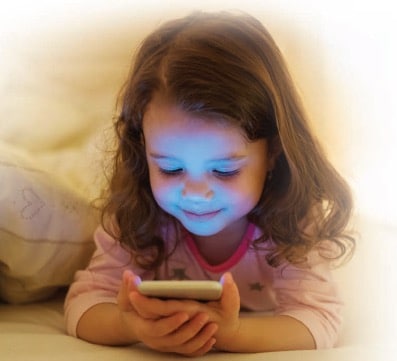More than a decade after the first iPhone was introduced to the public, smartphones have become present almost everywhere in American life. At work, school — even the dinner table; and through all hours of the day, the technology has become integrated rapidly into modern life, providing both opportunities and challenges for Catholics.
Post-millennials, the generation born after 1995, have grown up with the existence of the Internet — and for many of them, smartphones — as a given. While the transformations introduced by smartphones have benefited society, their negative effects have begun to gain more attention.
Two major investors in Apple recently called on the company to develop stronger parental controls to help limit children’s use of their products, and to invest in research on the long-term effects on childhood development of smartphone usage. Several figures who have worked in the technology industry at companies such as Facebook and Apple in the past year have begun to share their doubts about the world that they helped to build. Last year, a former vice president for user growth at Facebook told an audience at Stanford Graduate School of Business, “We have created tools that are ripping apart the social fabric.”
The family challenge
Like many families, Stephanie Zagrocki and her husband, Eric, have been navigating the new normal of children having a smartphone. The Catholic mother of six told Our Sunday Visitor her daughter in third grade recently asked if she could begin texting her friends. While that was too young, her older children received their phones in middle school or at the beginning of high school.

Her kids partly wanted a smartphone “to keep up with friends,” she said. But it’s become useful for her as well to text or call them to coordinate pick-ups from school or extracurricular activities, as well as to delegate household jobs to them.
The introduction of phones to the Zagrocki household also brings with it the challenge of guarding her kids from inappropriate content and language, and “monitoring it, as much as you can.”
Zagrocki explained she tries to be aware of what her kids are doing online and talks with them about what is appropriate and inappropriate to do. But as with so much of parenting, the older kids get, the more she has to trust they are doing the right thing on their own.
The progressive opening up of the world accomplished through mass media has meant increasing responsibility for parents to be aware of what, or who, is reaching and forming their kids as they grow up, especially in the case of the smartphone.
The average age to receive a first smartphone is now just over 10 years old, and teenagers spend nearly nine hours a day in front of a screen.
|
“The speed with which information is communicated exceeds our capacity for reflection and judgment, and this does not make for more balanced and proper forms of self-expression. … The world of communications can help us either to expand our knowledge or to lose our bearings. The desire for digital connectivity can have the effect of isolating us from our neighbors, from those closest to us. While these drawbacks are real, they do not justify rejecting social media; rather, they remind us that communication is ultimately a human rather than technological achievement.”
— Pope Francis, message for World Day of Communications, 2014
|
Authentic technology use
Technology’s proper role is to serve as a tool for authentic human development, explained Brian Gilchrist, a communications professor at Mount St. Mary’s University in Maryland. But he told OSV that society has lost control of that relation when it makes technology the whole focus of a culture, and “everything in society becomes reduced to information.”
Media theorist Neil Postman argued that instead of being an unqualifiedly good thing, overwhelming amounts of information “becomes a form of garbage, not only incapable of answering the most fundamental human questions but barely useful in providing coherent direction to the solution of even mundane problems.”

The smartphone, Gilchrist explained, encapsulates the danger Postman warned about, because it is built for the pursuit of new information.
He added the hardware and software of a smartphone has been designed to encourage frequent use.
“Most of these people operate under the assumption that they are making a device based upon the principles of addiction,” he said. The infinite scrolling found on a Twitter feed plays off the natural desire to know, while something as simple as the blue-toned light emitted by a screen, which mimics the effects of daylight, encourages staying up late.
“It’s a medium that constantly invites our attention,” he said. “It’s very hard not to engage the phone.”
Marshall McLuhan, another media theorist of the 20th century, argued that every time a new means of communication comes into a culture, the whole culture transforms in response. This includes both intentional changes and unintentional effects.
For the generation now entering adolescence and young adulthood, Gilchrist said, the smartphone has become the primary medium for communication. But the smartphone does not facilitate communication with other people, he said, so much as enable the “communication of the self.” Instead of serving generally as “a tool to help you connect to another person,” Gilchrist said it has resulted in a world in which men and women are often “surrounded by human beings, but thoroughly alone.”
Reorienting smartphones

David Cloutier, a professor of moral theology at The Catholic University of America, pointed out that technologies like smartphones or social media are actually social structures.
“They’re difficult to control on a purely individual basis,” he told OSV. An effective response to the problems introduced by smartphones, Cloutier explained, needs to recognize the solutions do not exist on a purely individual level, but require a broad social consensus.
In forming a response, Cloutier offered two effects of smartphones to keep in mind. First, he said, it is important to recognize that smartphones, like all technologies, are not neutral.
“All technologies have built-in biases; they’re good for some things and not good for others,” he said. With smartphones and social media, there’s an internal bias toward short, attention-grabbing content. As a medium, he added, it’s incapable of helping a person develop the skills for sustained, uninterrupted attention to a single topic.
Cloutier said it also is important to examine what smartphone technology does to human relationships. Catholic thought, he said, emphasizes that human beings are made to be in relationships with other people. He added that it would be foolish to deny that these technologies help people to connect to each other, but said that the quality of those connections — whether they are truly life-giving, and how they affect relationships — is vital.
Smartphones have a strong appeal for teenagers. Not only is there peer pressure to have a phone, but social media also offers the constant company of the social circle most important to teens: their peers. Nearly three-fourths of teenagers own a smartphone now, according to a report from the American Academy of Pediatrics.
In this respect, social media comes with benefits, explained Dr. Yolanda Reid-Chassiakos, a clinical assistant professor of pediatrics at UCLA. The connections facilitated by social media with friends and classmates can improve learning and bonding; for children with disabilities, social media can connect them to a support community they might not have otherwise.
And it’s ultimately fun to have. Bernadette Hayes, a high school senior, told OSV that “I’ll Snapchat back and forth with someone, and we won’t say anything the whole time: It’s just pictures. I think it’s hard for people who are older than us to understand, because it’s very pointless. I don’t even know why I do that.”
But along with the upside of being able to talk to friends all the time, Reid-Chassiakos said teens expose themselves to a variety of risks. Overuse of social media can encourage poor self-esteem and depression, affect weight gain and sleep patterns, and make teenagers vulnerable to advertising, cyberbullying and predation. Unhealthy behaviors by their peers, like self-harm or drug use, can become normalized through social media.
Dr. Gregory Bottaro, a clinical psychologist and executive director of the CatholicPsych Institute, told

OSV that smartphones are contributing to the increasing prevalence of anxiety and depression.
Recent studies suggest a significant association between social media use and depression in teenagers. Often, how someone participates matters as much as the length of time they spend online. Teens with active social lives also tend to be active on social media, but their mental health risks are lower than those who passively scroll through their social media feed and unfavorably compare their lives to what they see.
While Bottaro said available research hasn’t proven a causal relationship between usage and mental health disorders, technology addiction is a significant risk for children and contributes to a lack of socialization.
“Without having the experience of navigating the world of social interaction, they don’t build those pathways in their brain, and they never learn how to be good at it,” he said.
“Those who make use of the media of communications, especially the young, should take steps to accustom themselves to moderation and self-control in their regard. They should, moreover, endeavor to deepen their understanding of what they see, hear or read. They should discuss these matters with their teachers and experts, and learn to pass sound judgments on them. Parents should remember that they have a most serious duty to guard carefully lest shows, publications and other things of this sort, which may be morally harmful, enter their homes or affect their children under other circumstances.”
Competition for attention
The smartphone’s demand for attention, Gilchrist said, competes with deeply human activities. As a child, his favorite part of family gatherings over the holidays was hearing the stories different family members told. While stories are still being told, kids are not necessarily listening anymore, engrossed in the private world of their phone. Missing out on those stories, he said, means a teenager risks losing the sense he or she “belongs to a shared story.”
|
“The great challenge facing us today is to learn once again how to talk to one another, not simply how to generate and consume information.”
— Pope Francis, message for World Day of Communications, 2015
|
In his classroom, Cloutier increasingly has noticed in students a difficulty in reading books. He compared it to the challenge someone who never runs would have when told to run for an hour, compared to someone who runs daily. Students whose lives are filled with brief, concise snippets of information are unused to the discipline required to follow an author’s argument over 20 pages, he said.
And the effect of smartphones on prayer life also cannot be discounted. “I think using the smartphone to fill every possible gap of time in your life really does leave no room for God, no room for contemplation,” Cloutier added. He does not own a smartphone, he said. “There would be all kinds of useful things I could do. But I don’t think I could avoid the temptation to use it to fill any gap of time that I had.”
Hayes felt that teenagers were aware of many of the issues raised by smartphones, saying that social media “definitely” has an effect on relationships. When spending time with friends, she said she feels a constant need to check her phone, even though “I’m with the people I want to be with.” Checking a phone at any point in a conversation is so common now that it isn’t considered “insulting.”
“I hope that will change, but I don’t know if I see it changing.”
Parents lead the way
The attitude of parents toward their own phones and media usage plays an important role in the way children use these technologies. Reid-Chassiakos said that “overuse of media, avoidance of face-to-face communication, ‘checking out’ and engaging in inappropriate media” were all parental behaviors that strongly influenced how their children viewed technology and its comparative importance to people. Reid-Chassiakos encouraged parents to be involved in their children’s digital education. “Helping teens to learn the basics of good digital citizenship, as well as to balance their use of smartphones and social media with face-to-face activities, can reduce the risks of digital media overuse.”

Leah Murphy, the coordinator of digital evangelization at Life Teen, told OSV that parents should stay involved in the way their teens are engaging on social media, whether through access to their child’s account or following their account. But, she said, parents should never condemn or take a hostile approach to social media.
“When we start by affirming the many good ways that we can glorify God and lead people to Christ and share our joys with others on social media, that’s going to resonate a lot more with a teen than just telling them that they should stop spending so much time on Snapchat.”
In terms of limiting exposure to the downsides of social media, Murphy offered two practical recommendations. Committing oneself to following accounts or people that are edifying and positive re-establishes the role social media can serve in the pursuit of holiness. Placing limits upon usage is important, too, either through establishing a smartphone curfew or taking social media breaks.
Grassroots movements in the past year have appeared to rally communities to address the impact of social media and smartphones. Brooke Shannon, one of the founders of Wait Until 8th, said her organization empowers parents to delay giving their children a smartphone until eighth grade. When several families take that decision together, she said, “it flips the script” on the peer pressure for phone adoption.
Offline October began after Littleton, Colorado, lost several teenagers to suicide. By getting teenagers to take a month off from social media, it hopes to introduce an opportunity to strengthen face-to-face relationships and to realize “the happiness that can come from direct human interaction.”
For Angela Fernandes, a psychotherapist in Seattle, it’s imperative to address the social issues created by a smartphone-dependent culture. There is despair at not being more interesting than a phone, she said. For a culture enchanted by distraction, it is important to remember that “to love someone is to pay attention.”
Catholic evangelization
Murphy said she sees her work at Life Teen as “infusing truth, goodness, and beauty into the digital world.” She said she understands the negative attitudes toward social media, but added that it also could be a “huge force for good” in proclaiming the Gospel. In addition, Catholics need to respond to the invitation of Pope Benedict XVI to evangelize what he called “the digital continent.”
That does not mean that every Catholic’s social media feed needs to resemble Pope Francis’ Twitter account. Murphy said nobody should shy away from making explicitly Catholic posts, but that a feed should reflect an honest approach to faith and authentic desire to grow closer to Christ.

Sarah Yaklic, director of Grotto Network, the digital evangelization platform of the University of Notre Dame, said deeply authentic and human witness was a key in making sure online evangelization crosses into a person’s everyday life.
“When you think through how the Church is called to use new media,” she said, “Jesus didn’t invite us to be in relationship with a personal device. He called us to a personal encounter with himself and with those around us.”
The missionary mandate from Jesus to go spread the Gospel to ends of the world, she said, means Catholics have to be taking the new digital highways to that mission territory. Yaklic said that by entering social media platforms, the Church not only brings “the word of God and hope and inspiration to a dark world, but by our very presence, we transform those platforms.”
|
“The desire for connectedness and the instinct for communication that are so obvious in contemporary culture are best understood as modern manifestations of the basic and enduring propensity of humans to reach beyond themselves and to seek communion with others.”
— Pope Benedict XVI, message for World Day of Communications, 2009
|
The Church, she said, does the best job with digital evangelization when it develops authentic stories that inspire people to put down their devices and make space in their lives for contemplation and wonder. Her aim is to create content that inspires people to stop and ponder, as well as to bring up what they see in conversation with others.
Bernadette Hayes said that while she could imagine her life without a smartphone, she would never choose to be without one. The instant communication she can have with her friends is important to her, and the smartphone has become one of the integral pieces of American society. “It’s great for keeping up with people you don’t see every day,” she said, “but I see a need for it to change. People should just try harder to be present.”
Nicholas Wolfram Smith writes from California.





